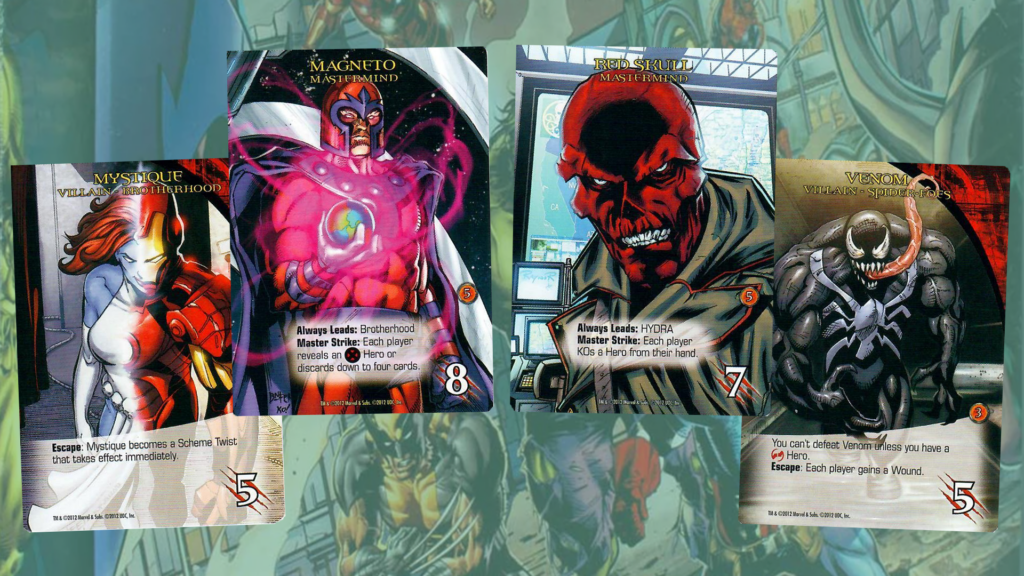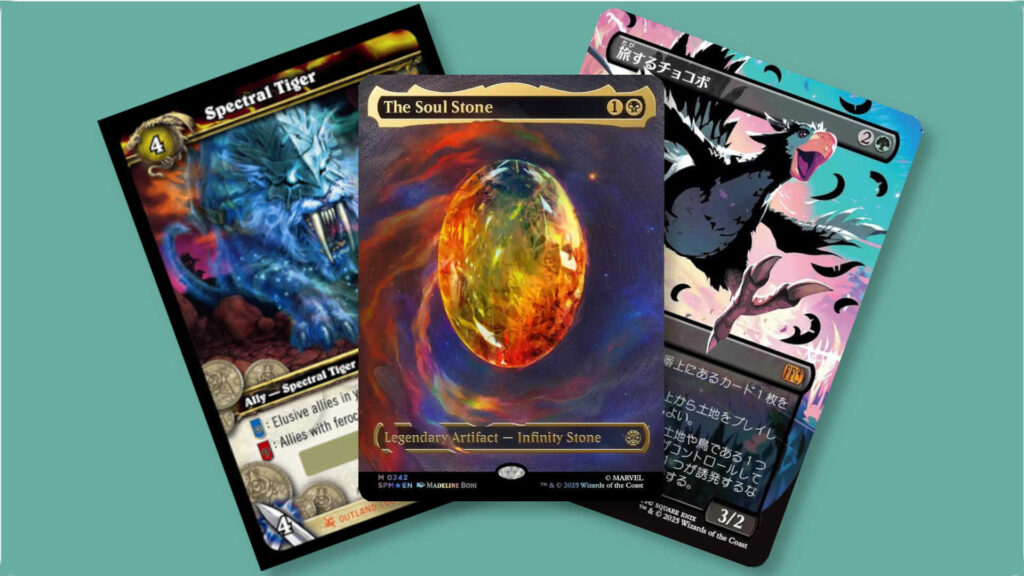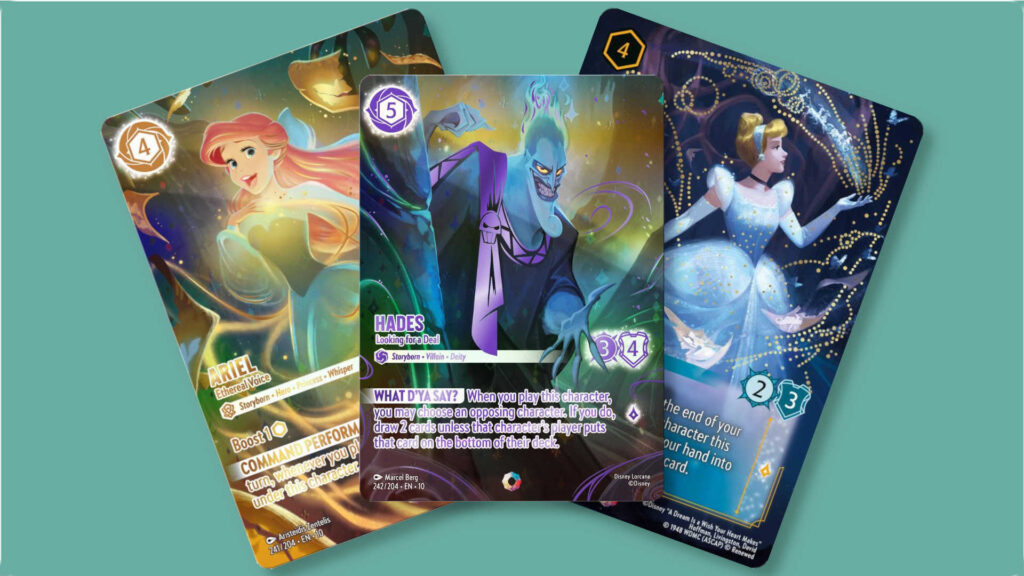Card scans sourced from https://www.legendarycardgame.com/
Today we’re talking about the masterminds and villains that debuted in Marvel Legendary‘s Core Set. We’ll explore how difficult they are to take down, and how fun they are as opponents. The game’s power level has increased significantly over time, so many of these old villains pale in comparison to the bad guys from more recent expansions.
If you enjoy this, we also have an article assessing the heroes from the Core Set.
Table of Contents
ToggleMasterminds in the Marvel Legendary Core Set
Red Skull

Red Skull, what have they done to you? This game does Red Skull dirty; you’d almost feel sorry for him if he wasn’t a megalomaniacal wannabe dictator. In Marvel Champions this scarlet supervillain gets to be the antagonist of his own expansion, The Rise of Red Skull. In Legendary, meanwhile, he’s a walking punchline. The weakest mastermind in the game by far, he’s even weaker than some basic villains. Red Skull is the perfect punching bag if you’re looking for an easy win.
Red Skull’s master strike and all of his tactics benefit the players. Any combination of five heroes can take him down. Against Red Skull you may spend longer setting the game up and packing it away than you will playing. For that reason, I don’t personally enjoy games against him, but I can see the appeal for players just looking to unwind by socking him a haymaker right in his smug skeletal jaw.
Magneto

Magneto is more challenging than Red Skull, although that’s not saying a lot. It’s a shame that the most iconic X-Men antagonist is one of the game’s weakest masterminds. Unlike Red Skull, Magneto does have one tactic that can harm players, although only if they don’t have any X-Men in their hand.
Magneto’s master strike forces every player to reveal an X-Men hero from their hand or discard down to four cards. While it’s easy to get around this effect, if you’re caught unprepared then this sets your momentum back significantly.
When putting a deck together to fight Magneto you get rewarded for bringing along plenty of X-Men. Additionally, the Brotherhood, the villainous team Magneto always leads, contains characters that punish you for not running X-Men. At only eight attack, Magneto is very easy. You can challenge yourself by going up against him using a setup with no X-Men at all, sacrificing thematic consistency for an increase in difficulty.
Dr. Doom

Like his two predecessors, Dr. Doom is a beginner-friendly mastermind who won’t throw out any unexpected curveballs.
None of Dr. Doom’s tactics are detrimental. Although there is one that lets you hurt other players, but only if you specifically choose to. And you wouldn’t do that… right?
Dr. Doom’s master strike makes every player with exactly six cards in their hand put two cards back on top of their deck. This is worse than discarding a card, since you’ll clog up the top of your deck with weak S.H.I.E.L.D. cards. You can get around this by revealing a technology hero, or by having fewer or greater than six cards in your hand.
Dr. Doom is an enjoyable mastermind. Beyond wanting you to run at least one technology hero to get around his master strike, he doesn’t impose any limits on your deck building. When you’ve got a hard scheme it can be a good idea to pair it with a simple mastermind. Dr. Doom fits that bill perfectly.
Loki

The Norse trickster god is the hardest mastermind in the Core Set. The power level of Marvel Legendary has risen dramatically since the game began, and Loki doesn’t seem so tough compared to masterminds like Thanos, Dark Phoenix, or Exodus. Nevertheless, it’s still best not to underestimate him.
Loki’s tactics aren’t hard to handle, although you may end up annoying the rest of the table since some of them reduce other players’ victory points. Unlike his tactics, Loki’s master strike does pose a threat. Every player must reveal a strength hero from their hand or take a wound. The Enemies of Asgard have several characters that wound you if you don’t have any ranged heroes. This means that in games against Loki, you need to ensure that you run both strength and ranged heroes.
Fortunately, in a stroke of game design that’s both cruel and clever, Thor offers cards in both of these classes, rewarding you for pitting Loki against his brother. As well as Thor, Cyclops also offers a mixture of strength and ranged cards, making him another useful pick against Loki. If you want to recreate the first Avengers movie by having him take on Captain America, Iron Man, Thor, Black Widow, and Hulk, go ahead. Loki isn’t tough enough to force you to build around him.
Villains in the Marvel Legendary Core Set
Spider-Foes




Photos courtesy of Upper Deck Entertainment
The Spider-Foes are the easiest villain group in the game. Just ensure that you get some impulse heroes to fight Venom.
With an attack value of three, The Lizard is as weak as a basic henchman. Make sure that you wait a little while to take him on because he’ll inflict wounds on the other players if you fight him in the sewers.
Doctor Octopus is actually super helpful. This eight-armed adversary isn’t a challenge to fight, and you’re rewarded handsomely for taking him down. The turn after you fight Doc Oc, you get to draw a new hand of eight cards. This is an incredibly powerful bonus that should be saved for the mid or late game when you can utilize it best.
Venom is the most frustrating of these villains, as you need an impulse hero to attack him, and he wounds everyone if he escapes. Still, this is a condition that’s easy to fulfill.
The Green Goblin captures a bystander as he enters play, and requires six attack value to be taken down. You’ll get five victory points for beating him though (four from him and one from the bystander). If he escapes you’ll be forced to discard a card thanks to that kidnapped bystander
HYDRA




Photos courtesy of Upper Deck Entertainment
HYDRA would be down there with the Spider-Foes as another set of super easy starter villains to take on, but one of their cards pushes their difficulty up significantly. You don’t need to choose any specific heroes to fight them.
HYDRA Kidnappers is very weak; when you fight them you’re allowed to recruit a S.H.I.E.L.D. Officer. Unless there’s a very costly hero in the HQ that you really want, it’s usually best to turn this offer down. S.H.I.E.L.D. Officers pad out your deck and they don’t contribute as much as many other heroes.
The Endless Armies of HYDRA are the nastiest villain in the Core Set. Three copies of this are shuffled into the villain deck when you play against HYDRA. In Legendary, the villain deck acts as a timer. The game ends in a draw if it is fully depleted and you’ve not beaten the mastermind. Many schemes also end the game in a loss after too many scheme twists are revealed. Whenever you fight the Endless Armies of HYDRA you’re forced to play the top two cards of the villain deck, losing two valuable turns worth of time. Just ignore The Endless Armies of HYDRA, this card’s effect is so brutal that it’s not worth confronting it.
Like the Endless Armies, Viper also has a negative effect when you take her on. If you fight Viper, or she escapes, then she wounds every player with no HYDRA villains in their victory pile. Try to ensure that she won’t wound anyone.
Supreme HYDRA has the highest stats of the HYDRA villains, but he’s far more manageable than their Endless Armies. This card is worth three points, plus an additional three points for every other HYDRA villain in your victory pile. Don’t let this lure you into taking on the Endless Armies of HYDRA unnecessarily though – you’ll regret it.
Masters of Evil




Photos courtesy of Upper Deck Entertainment
The Masters of Evil care about two things: Avengers and technology heroes. This makes characters like Iron Man and Hawkeye, who are both, great choices for taking them down. While they have better stats than the Spider-Foes or HYDRA, they’re still not very challenging.
Whirlwind lets you KO two heroes if you fight him on the rooftops or the bridge. Let’s take a moment to appreciate the designers giving the weather-based supervillain an effect that activates when you fight him outside. Like Doctor Octopus, Whirlwind is another very helpful villain. KOing two heroes helps thin your deck in the early and mid game. In the late game, when you wouldn’t want to do this, just fight him at a location where his ability won’t activate.
Melter is another helpful villain. When you fight him, everyone reveals the top card of their deck, and you can choose whether to KO it or keep it where it is. Use this power to KO S.H.I.E.L.D. cards.
Ultron has a victory point modifier that grants you an additional VP for every technology hero in your deck. He also wounds every player who doesn’t have a technology hero if he manages to escape. If you’re running a tech build, then be sure that you’re the one to take Ultron out.
Zemo is worth a decent total of four victory points by default. He then gives you bystanders, and thus more points, for every Avenger you control when you take him down. Zemo doesn’t have any negative effects, so fight him once you’ve built up a decent hand of Avengers to reap your reward.
Skrulls




Photos courtesy of Upper Deck Entertainment
The Skrulls are great. The game captures their shapeshifting flavor perfectly; they mimic heroes from the HQ, requiring the same attack value to fight as the cost of the hero they are copying. Playing against the Skrulls impacts how you should set up the hero deck. Emphasize heroes who provide attack. 3/4 of the Skrulls let you recruit new heroes when you beat them up, making attack an even more important currency than it already was.
Super Skrull is a sinister shapeshifter who lets every player KO one of their heroes when he’s taken down. If it’s very late in the game, you may need to check to be sure that no one has a handful of heroes that they don’t want to lose. Otherwise, it’s always great to take this Skrull down.
Skrull Shapeshifters steal the rightmost hero from the HQ when they enter play. They might steal a Spiderman card with two attack power, or they might steal an ultimate and require eight attack to be taken down. The risk equals the reward though, and you can net yourself some great cards by fighting them. Coordinate with other players about who will finish them off so that the hero goes where it’s needed the most.
Paibok, the Power Skrull is formidable for a Core Set villain. Paibok is as tough as Magneto, requiring eight attack power to take down. The reward you get for beating this card makes it worth it. Every player gets to recruit a hero of your choice from the HQ. Save taking this card on for when some powerful ultimates are available, and you’ll be all set up to win the game.
Skrull Queen Veranke is a harder variant of Skrull Shapeshifters. Rather than taking the hero in the rightmost space of the HQ, Veranke steals the costliest hero available. Like Paibok, she’s tough to take on, but the reward makes it worthwhile.
Radiation




Photos courtesy of Upper Deck Entertainment
These are a selection of bad guys from the Hulk’s rogues gallery. Appropriately enough, they reward you for running lots of strength heroes so you’re incentivized to use Bruce Banner against them. They’re hard by Core Set standards, but they’re still very manageable.
The Leader has a tricky ambush effect. When the Leader enters play, he immediately puts the top card of the villain deck into play. If you’re already in a bad situation, this card makes things much worse. When you’re playing against Radiation, be aware that The Leader is out there, and make sure you’re prepared to handle two cards coming down at once.
Abomination isn’t so bad. With an attack value of five, he’s durable, but he rewards you by giving you three bystanders if you fight him in the streets or on the bridge. This effectively doubles the number of points that he’s worth; time when you fight him correctly to get this bonus.
You want to make sure when you take ZZZAX on that you and the other players all have a strength hero available, or you’ll all take a wound. If you’re running a Hulk deck, some of his cards reward you for accumulating wounds so you can opt not to reveal anything. That’s probably not a great strategy though, all things considered.
Maestro lets you KO one of your heroes for every strength hero that you have. This can be very useful, but remember this effect is not optional. It can be quite punishing to fight Maestro if your hand is loaded up with strength heroes. Hit this guy early on when you still have some S.H.I.E.L.D. cards to KO, or have a player who hasn’t been focusing too much on strength fight him.
Brotherhood




Photos courtesy of Upper Deck Entertainment
Magneto’s Brotherhood of Mutants are one of the toughest villain groups in the Core Set. Their cards are reasonably strong, and they all have impactful effects. Ensure that you’ve got some X-Men available.
Blob is the weakest villain in the Brotherhood, but also one of the most annoying. You need to play an X-Man to take him down. He doesn’t have a high attack value, but he’s a major reason why it’s important to bring some X-Men along whenever you fight the Brotherhood.
Never let Mystique escape! Many schemes cause you to lose the game when a certain number of twists have resolved, so throwing an additional unanticipated twist into the mix is painful. Mystique is a kill-on-sight card, due to the massive headache she’ll cause if she gets away.
Sabretooth is another reason why it’s good to bring the X-Men to face the Brotherhood. Wolverine’s rival will damage every player who doesn’t have one of the X-Men in their hand when he gets fought or when he escapes.
The Juggernaut will come in like a wrecking ball when you least expect him. When the Juggernaut enters play, he KOs two heroes from everyone’s discard pile. Since you have no way of knowing when this will come, you can’t prepare. Hopefully everyone will have some spare S.H.I.E.L.D. cards and everything will work out, but in a worst-case scenario you may lose some valuable cards.
Enemies of Asgard




Photos courtesy of Upper Deck Entertainment
The Enemies of Asgard are probably the hardest villains in the Core Set. With reasonably high attack values, and plenty of ways to inflict wounds. Pack some ranged heroes against them.
The Frost Giants are the weakest of the Enemies of Asgard. Ensure that everyone has a ranged hero in their hand before fighting the giants or else everyone takes a wound. They also wound everyone without a ranged hero if they escape.
Enchantress lets you draw three cards for taking her down. While this is highly beneficial, just remember you draw the cards immediately rather than at the start of your next turn.
Ymir, Frost Giant King is the only Core Set card that deals damage via an ambush effect. This damage can be prevented by revealing a ranged hero. Hope that you draw him late in the game when meeting this condition is less of an issue. When you fight Ymir, he gets rid of all of the wounds in any player’s hand and in their discard pile. It’s unclear why Ymir is healing you, but take the blessing and don’t question it.
Destroyer has an attack value of seven. If you take them down, you can KO all of your S.H.I.E.L.D. heroes. Never run Nicky Fury, or any S.H.I.E.L.D. characters from an expansion, if you’re going to take on the Destroyer. Also don’t let the Destroyer escape, since they KO two cards from everyone’s hands as they leave. While this helps out in the long term, by getting rid of S.H.I.E.L.D. cards, it’ll put you all in a very tough spot with fewer resources available for your next turn.
Conclusion
So, there we have all of the villains from the Legendary Core Set. Do these cards stand the test of time or are they beginning to show their age?
Everything here is a lot easier to deal with than contemporary cards; Red Skull and Magneto feel particularly underwhelming.
The lack of complexity can be a positive. Many more modern villains are covered in keywords and can do all sorts of things like ascending to become new masterminds or become a location. While this denser style of gameplay is fun, sometimes it’s nice to fight a group like the Enemies of Asgard who are reasonably tough, but easy to keep track of. The Skrull’s transformation gimmick is also neat.
Upper Deck recently announced that they intend to release a second edition of the core set. We’re likely to see reworked versions of these iconic villains, in line with the game’s modern design sensibilities. It’ll be good to take on a Magneto that’s as threatening as his comic counterpart.
Overall, there’s still a lot to recommend about the villains from Legendary’s Core Set. They aren’t tough or complex, but that’s not so bad.
Wanna know more? Check out our guide to learning how to play Marvel Legendary.




